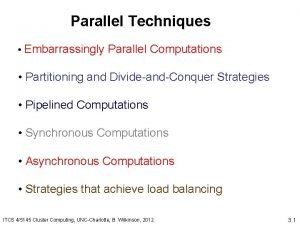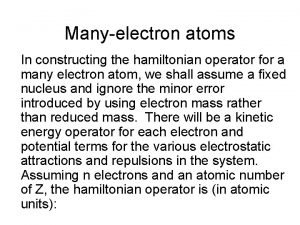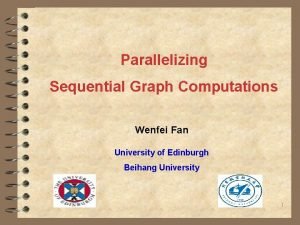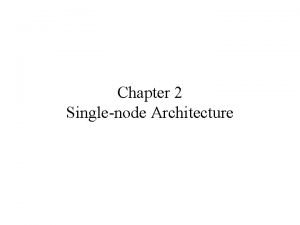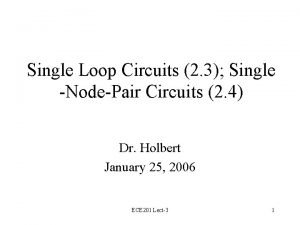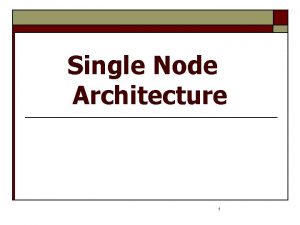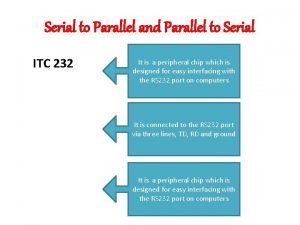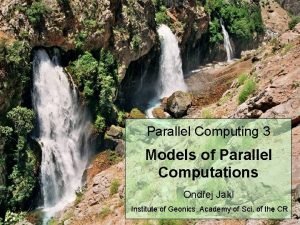Parallel Computations Serial Computations Single computing node From

















- Slides: 17

Parallel Computations

Serial Computations • Single computing node • From beginning to end in series

Parallel Computations • Definition: Use of two or more processors in combination to solve a single problem

Parallel Computations • Simple parallel computation – N computing nodes – N separate jobs • Not depending on each other • Taking the same amount of time for all jobs • Distributed easily to the computing nodes – The work would be done N times faster than N serial computations in principle – Called “embarrassingly parallel”

Parallel Computations • Less simple parallel computation – N separate jobs • Still no interaction • Taking widely different amounts of time – Distribute one job to every processor • Putting longer jobs first and shorter ones later • New job will be put to processors done their jobs – “Single queue multiple server” system – Cannot be N times faster

Parallel Computations • Single-job parallelization – A single job taking a very long time – Reorganizing the job to break it into pieces that can be done concurrently – There could be periods when most jobs are just waiting around for some other tasks to be done – Example: Building a house • Plumbing, electrical, foundation, flooring, ceiling, roofing, walls, etc. • Many jobs can be done at the same time • Some have specific orderings (e. g. , the foundation first before the walls go up) – Not scaled by N – Most challenging case for parallelization

Memory Architectures • Shared memory – Multiple processors can operate independently but share the same memory resources – Changes in a memory location effected by one processor are visible to all other processors.

Memory Architectures • Distributed memory – Requires a communication network to connect inter-processor memory – Processors have their own local memory – Memory addresses in one processor do not map to another processor no global address space

Parallel Programming • Identification of parallelizable problems • Example of parallelizable problem Calculate the potential energy for each of several thousand independent conformations of a molecule. When done, find the minimum energy conformation – Each of the molecular conformations is independently determinable – The calculation of the minimum energy conformation is also a parallelizable problem.

Parallel Programming • Example of non-parallelizable problem Calculation of the Fibonacci series (1, 1, 2, 3 , 5, 8, 13, 21, . . . ) by use of the formula: F(k + 2) = F(k + 1) + F(k) – This is a non-parallelizable problem because the calculation of the Fibonacci sequence as shown would entail dependent calculations rather than independent ones. – The calculation of the k + 2 value uses those of both k + 1 and k. These three terms cannot be calculated independently and therefore, not in parallel.

Parallel Programming • Identification of the program’s hotspots – Know where most of the real work is being done. The majority of scientific and technical programs usually accomplish most of their work in a few places. – Profilers and performance analysis tools can help here – Focus on parallelizing the hotspots and ignore those sections of the program that account for little CPU usage.

Parallel Programming • Identification of bottlenecks in the program – Are there areas that are disproportionately slow, or cause parallelizable work to halt or be deferred? For example, I/O is usually something that slows a program down. – May be possible to restructure the program or use a different algorithm to reduce or eliminate unnecessary slow areas

Array Processing – Serial Example • Calculations on 2 -D array elements, with the computation on each array element being independent from other array elements • The calculation of elements is independent of one another - leads to an embarrassingly parallel situation. Serial code do j = 1, n • The problem should be do i = 1, n computationally intensive. a(i, j) = fcn(i, j) end do

Array Processing – Parallel Solution • Arrays elements are distributed so that each processor owns a portion of an array (subarray). • Independent calculation of array elements insures there is no need for communication between tasks. • Distribution scheme is chosen by other criteria, e. g. unit stride (stride of 1) through the subarrays. Unit stride maximizes cache/memory usage. Paralle code • Since it is desirable to have unit stride through the subarrays, the choice of a distribution scheme do j = mystart, myend depends on the programming language. do i = 1, n • After the array is distributed, each task executes a(i, j) = fcn(i, j) the portion of the loop corresponding to the data end do it owns. For example, with Fortran block end do distribution: • Notice that only the outer loop variables are different from the serial solution.

Parallel Example – π Calculation • Inscribe a circle in a square • Randomly generate points in the square • Determine the number of points in the square that are also in the circle • Let r be the number of points in the circle divided by the number of points in the square • π ~ 4 r • Note that the more points generated, the better the approximation

Parallel Example – π Calculation • Serial code npoints = 10000 circle_count = 0 do j = 1, npoints generate 2 random numbers between 0 and 1 xcoordinate = random 1 ; ycoordinate = random 2 if (xcoordinate, ycoordinate) inside circle then circle_count = circle_count + 1 end do PI = 4. 0*circle_count/npoints

Parallel Example – π Calculation • Paralle code npoints = 10000 circle_count = 0 if I am MASTER p = number of tasks num = npoints/p receive from WORKERS their circle_counts compute PI (use MASTER and WORKER calculations) find out if I am MASTER or WORKER else if I am WORKER do j = 1, num generate 2 random numbers between 0 and 1 xcoordinate = random 1 ; ycoordinate = random 2 if (xcoordinate, ycoordinate) inside circle then circle_count = circle_count + 1 end do send to MASTER circle_count endif
 Embarrassingly parallel
Embarrassingly parallel Reference node and non reference node
Reference node and non reference node Reference node and non reference node
Reference node and non reference node Constructive interference
Constructive interference Typedef struct node node
Typedef struct node node Parallel spin
Parallel spin Struct node int data struct node* next
Struct node int data struct node* next Node red java
Node red java Incrementalizing graph algorithms
Incrementalizing graph algorithms Bidirectional shift register with parallel load
Bidirectional shift register with parallel load Halimbawa ng serial soap opera
Halimbawa ng serial soap opera Single node architecture in wireless sensor networks
Single node architecture in wireless sensor networks Branch in electrical circuit
Branch in electrical circuit Example 3
Example 3 Single node architecture
Single node architecture Conventional computing and intelligent computing
Conventional computing and intelligent computing Serial vs parallel ports
Serial vs parallel ports Serial and parallel communication
Serial and parallel communication
